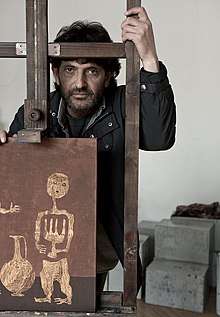Ashot Avagyan
Ashot Avagyan (Armenian: Աշոտ Ավագյան; born May 20, 1958) is an Armenian painter. Many of his works depict the suffering and loss he experienced during the Nagorno-Karabakh War,[1] and inspired by ancient megalithic structures and ancient petroglyphs found in Syunik Mountains.[2]
Ashot Avagyan | |
|---|---|
 Ashot Avagyan in his art studio in Sisian | |
| Born | May 20, 1958 |
| Nationality | Armenian |
| Known for | Painting, Drawing www.ashotavagyan.com |
Early life
Ashot Avagyan was born in 1958 in Sisian, Armenia. He defeated the region, the city and the megalithic structures during the war in Nagorno Karabakh.[3]
Career
In 1981 graduated from the Yerevan Art College after P. Terlemezyan. He lives and develops his work in Sisian. From 1981 till now teaches at Children Art School in Sisian. Having the cultural heritage of different time periods of his living area as a standing point, the artist always seeks for searching new perspectives of world-perception. The conceptual and artistic prospects of Neolithic petroglyphs to Middle Age iconographic culture are transposed from the surface of canvas into the forms of modern art, appearing in the context of performance. Ashot is regularly creating art exhibitions in Sisian and attracts thousands of people to take part.
Personal life
Ashot Avagyan devoted his life to teaching children in the remote town in South Armenia.
One – Man Shows
2000 – "The seven papers of Demiurge", Chamber Theatre, Yerevan, Armenia
2004 – "Magic double circle", Gevorgyan Gallery, Yerevan, Armenia
2008 – "Memories from previous life", Gevorgyan Gallery, Yerevan, Armenia
Performances
Involve the areas of cultural and cult monuments of Neolithic period in Sisian (Ukhtasar petroglyphs, Zorats Karer, Portakar).
1999 – "Dialogue"
2000 – "The Way"
2001 – "Forgive me, Mama!"
2002 – "Magic Double Circle"
2003 – "Reincarnation"
2004 – "Fertility"[4]
2006 – "Return". With Azat Sargsyan in the frame of the 5th Gyumri Biennale
2007 – "Return - 2"
2008 – "Sacrifice"[5]
2010 – "Return – 3"
2011 – "Return – 4"
2012 – "Sacrifice – 2"
Group Shows
2001 – "Four Armenian artists", Toronto, Canada; Copenhagen, Denmark
2002 – "Show of avant-garde art", ACCEA, Yerevan, Armenia
2003 – "Transcendents", Albert and Tove Boyajyan Gallery, Yerevan, Armenia
Dublin, Ireland; New York, USA; Montreal, Canada
2004 – The 4th Gyumri International Biennale, Gyumri, Armenia
Art Expo "ART CAUCASUS", Tbilisi, Georgia
2005 – Art Expo "ART CAUCASUS", Tbilisi, Georgia
2006 – Abdala Al-Salem Hall, Kiewit, Kiewit
"The colors of Armenia", IFEFEL, Saint –Petersburg, Russia
"Meeting with Saryan", National Gallery, Yerevan, Armenia
2007 – "Colors of Armenia", G.Gyulbenkian center, Aleppo, Syria;
"Colors of Armenia", AGBU, Damascus, Syria
"From Ararat to Fuji", National Gallery, Yerevan, Armenia
"Contemporary artists from Armenia", Armenian General Benevolent Union,
Pasadena, USA
Armenian Landscapes in Contemporary Art", Untewerk Selnau, Kultur und
Eventhaus, Zurich, Switzerland
2008 – The 6th Gyumri International Biennale, Stil Gallery, Gyumri Armenia;
"Recovering wounds", Museum of Spitak Earthquake, Spitak, Armenia; branch of National Gallery in Vanadzor, Vanadzor, Armenia
"Generation Freedom: Armenia's New Vanguard", InterArt Gallery, New York,
USA
Catalogues
1. Art Caucasus. Art Expo-2004. Tbilisi: Art Caucaus, 2004, [Eng.]
2. Gevorgyan Gallery. Yerevan: Gevorgyan Gallery, 2004, [Arm., Eng.]
3. Art Caucasus. Art Expo-2005. Tbilisi: Art Caucaus, 2005, [Eng.]
4. The 4th Gyumri International Biennale. Yerevan: GCCA, 2005, [Arm., Eng.]
5. The colors of Armenia, contemporary Armenian artists. Yerevan: Tigran Mets, 2006, [Russ.]
6. The 5th Gyumri International Biennale. Yerevan: GCCA, 2006, [Arm., Eng.]
7. Armenian Landscapes in Contemporary Art. Yerevan, 2007, [Germ., Eng.]
8. Contemporary Artists from Armenia. Pasadena: AGBU, 2007, [Eng.]
9. Generation Freedom: Armenia's New Vanguard. New York: RAH, 2008, [Eng.]
10. Recovering wounds. Yerevan: GCCA, 2008, [Arm., Eng.]
Work with Qarahunge archaeological site
Since December 2010 Ashot Avagyan has been the Director of Qarahunge (Zorats Karer) megalithic historical complex in Sisian. He assisted with the Oxford University Expedition to Qarahunge.[6] Avagyan continues to work with expedition leader Mihran Vardanyan to create a healthy scientific and cultural climate around the monument in order to attract more tourists.[7]
See also
References
- Ashot in 1993
- Life and Death of Ashot Avagyan, Artist of Sisian
- Armenia (Chapter)
- Artistic Reconstruction of a Fertility Ritual on YouTube
- Sacrifice and other works by Ashot Avagyan
- Ashot Avagyan and Oxford Expedition Archived December 28, 2010, at the Wayback Machine
- Tourism Development Zorats Karer Tourism Development
Further reading
External links
| Wikiquote has quotations related to: Ashot Avagyan |